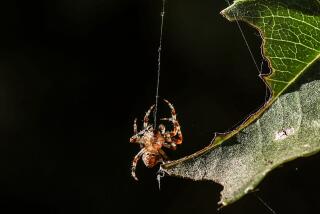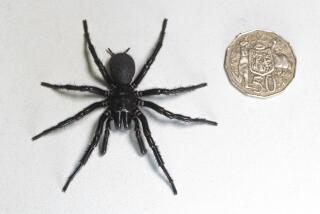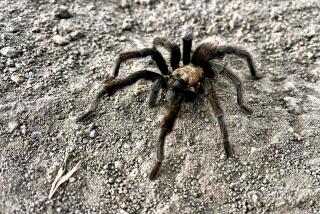City living makes spiders big, fat and fertile, researchers say
- Share via
City living can really have its perks – if you’re a spider. Golden orb-weaving spiders that lived in urban areas were bigger and more successful than their country-dwelling counterparts, according to a team of Australian scientists.
The findings, published in PLOS One, detail the complexity of urbanization on animals that manage to survive, even thrive, in a man-made environment.
“Urbanization modifies landscapes at multiple scales, impacting the local climate and changing the extent and quality of natural habitats,” the study authors wrote. Usually it degrades those habitats and species struggle to survive, but some, like pigeons and raccoons, become “urban exploiters,” readily adapting to the new environment.
But birds and rodents are relatively large, mobile creatures, and the University of Sydney researchers wanted to see how the urbanization effect played out on small as well as large scales. They focused on Nephila plumipes, known as the golden orb-weaving spider, because these eight-legged critters like to settle down once they mature: They spin beautiful semipermanent webs and then hang out there for the rest of their lives, which makes it easier to measure how the environment affects them.
The researchers collected 222 female spiders from different sites around Sydney and measured each site’s level of urbanization, based on qualities such as leaf-litter cover, grass coverage and amount of hard surfaces like concrete. They measured the web-spinners’ body size, fat reserves and ovary weight (to evaluate their reproductive capacity).
Sure enough, the more urban the area, the bigger, fatter and more potentially fecund the spiders were. The researchers think this is in part because spiders tend to do better in warmer environments, and cities are “urban heat islands”: Concrete and buildings tend to absorb heat rather than dissipate it the way moist earth and vegetation do.
It’s also possible that tasty insect meals tend to cluster near city lights, making them easier to catch, or that there tends to be a higher density in the boundaries between the fragmented patches of urban and wild lands.
Oddly enough, the spiders seemed to prefer luxurious living: Ovary weight also increased in areas with higher socioeconomic status.
“The increased expenditure and management of parks in wealthy suburbs could result in healthier vegetation patches,” the researchers wrote, “which would increase prey abundance and allow spiders to grow larger and build up fat reserves.”
Looking for a nice two-bed, two-bath starter web in a corner of downtown? Follow @aminawrite for more strange science news.







